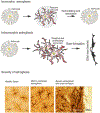Principles of Astrogliopathology
- PMID: 34888830
- PMCID: PMC8999877
- DOI: 10.1007/978-3-030-77375-5_3
Principles of Astrogliopathology
Abstract
The role of astrocytes in the nervous system pathology was early on embraced by neuroscientists at end of the nineteenth and the beginning of the twentieth century, only to be pushed aside by neurone-centric dogmas during most of the twentieth century. However, the last decade of the twentieth century and the twenty-first century have brought the astroglial "renaissance", which has put astroglial cells as key players in pathophysiology of most if not all disorders of the nervous system and has regarded astroglia as a fertile ground for therapeutic intervention.Astrocytic contribution to neuropathology can be primary, whereby cell-autonomous changes, such as mutations in gene encoding for glial fibrillary acidic protein, can drive the pathologic progression, in this example, Alexander disease. They can also be secondary, when astrocytes respond to a variety of insults to the nervous tissue. Regardless of their origin, being cell-autonomous or not, changes in astroglia that occur in pathology, that is, astrogliopathology, can be contemporary and arbitrary classified into four forms: (i) reactive astrogliosis, (ii) astrocytic atrophy with loss of function, (iii) pathological remodelling of astrocytes and (iv) astrodegeneration morphologically manifested as clasmatodendrosis. Inevitably, as with any other classification, this classification of astrogliopathology awaits its revision that shall be rooted in new discoveries and concepts.
Keywords: Astrocyte; Astrocytic atrophy; Neuropathology; Pathological remodelling; Reactive astrogliosis.
© 2021. The Author(s), under exclusive license to Springer Nature Switzerland AG.
Figures





References
-
- Achucarro N (1910) Some pathological findings in the neuroglia and in the ganglion cells of the cortex in senile conditions. Bull Gov Hosp Insane 2:81–90
-
- Alberdi E, Wyssenbach A, Alberdi M, Sanchez-Gomez MV, Cavaliere F, Rodriguez JJ, Verkhratsky A, Matute C (2013) Ca2+ -dependent endoplasmic reticulum stress correlates with astrogliosis in oligomeric amyloid beta-treated astrocytes and in a model of Alzheimer’s disease. Aging Cell 12:292–302 - PubMed
-
- Alzheimer A (1910) Beiträge zur Kenntnis der pathologischen Neuroglia und ihrer Beziehungen zu den Abbauvorgängen im Nervengewebe. In: Nissl F, Alzheimer A (eds) Histologische und histopathologische Arbeiten über die Grosshirnrinde mit besonderer Berücksichtigung der pathologischen Anatomie der Geisteskrankheiten, vol 3. Gustav Fischer, Jena, pp 401–562
-
- Anderson JL, Head SI, Morley JW (2012) Duchenne muscular dystrophy and brain function. In: Muscular dystrophy. InTech - PubMed
MeSH terms
Grants and funding
LinkOut - more resources
Full Text Sources
